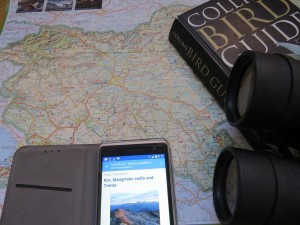A Short Birdwatchers’ Tourist Guide
// Jernej Figelj
Slovenia lies on the junction of the Mediterranean, the Alps and the Pannonian Plain, so consequently the diversity of its habitats, flora and fauna is exceptional. For this very reason, Slovenia is of great interest to visitors from around the world, since everyone will find something of special interest here. Its small size and many roads are giving us the chance to observe glacial relicts in the morning and typical Mediterranean species in the evening, all on the same day.
Waterfowl lovers
The most popular places for waterfowl lovers are the Sečovlje Saltpans, Škocjan Inlet Nature Reserve, the Drava and Mura Rivers and Lake Cerknica. Common water bird species can be observed in all of these areas. Some species like the Little Tern (Sterna albifrons), Kentish Plover (Charadrius alexandrinus) and a couple of Mediterranean species with their northernmost range in Slovenia – Cetti’s Warbler (Cettia cetti) and Sardinian Warbler (Sylvia melanocephala) – can be seen only at the coast. The River Drava is very interesting during the spring and autumn migration. Some species like the Penduline Tit (Remiz pendulinus) and the White-tailed Eagle (Haliaeetus albicilla) breed only in the eastern part of Slovenia, and the Drava and Mura Rivers are certainly the best places where one can observe these species.
If you are interested in forest birds
Every part of Slovenia is, in principle, rich with forest birds. No wonder, since almost 60 % of Slovenia is covered by forests. For visitors from the countries deprived of forests, a short walk through Ljubljana’s Rožnik or Golovec could already be a wonderful experience. Bird lovers are particularly impressed by primeval forests. The best known primeval forest remains in Slovenia are in the Krakovski primeval forest near Kostanjevica pri Krki and in the Kočevsko region (Pečka, Krokar, Rajhenav).
Birds of the cultural landscape
As the number and diversity of farmland birds is rapidly declining in Slovenia and Europe in general, the number of places where one can experience all the colours and sounds of a real mosaic of cultural landscape is declining as well. Some of these magical feelings can still be experienced in remote areas or in places where harsh nature conditions (marshes, rocky and steep terrains…) are making intensive land use impossible. South-western Slovenia, especially Istra and Kras, are rich with different skylark and bunting species, while Ljubljansko barje and Lake Cerknica boast wet meadows in which species like Grasshopper Warbler (Locustella naevia), Corncrake (Crex crex) and Marsh Warbler (Acrocephalus palustris) can be observed. A must-see are Kozjansko and Goričko, the regions where the traditional mosaic-like landscape composed of traditional high-stemmed tree orchards, dry and wet extensive meadows and blue weedy fields has been preserved. With some luck even the rare and endangered Roller (Coracias garrulus) can be seen.
Alpine birds
Because the Alps are covered by snow roughly from late autumn till late spring, the span of time for birdwatching is short. The best way to observe Alpine birds is to go hiking for a couple of days, walk through high altitude areas and spend the nights in one of Slovenia’s many mountain cottages. If we don’t have time or if we aren’t able to take long walks, then we can reach the high altitudes with cable cars, the majority of which are operating during the summer as well. A popular visiting point is also the Mangrtsko sedlo that is accessible even by car.
